A Success story…Zimbabwe relocates wildlife from Savé Valley Conservancy to Sapi Reserve within the Mana-Sapi-Chewore biosphere
The articles on which this is based came from the website of the Journal of African Elephants (https://www.africanelephantjournal.com) an excellent source that exists to enhance and increase global awareness of the plight of Africa’s savanna and forest elephants.
Background
The Savé Valley Conservancy website proudly states: “We have a proud and enviable heritage of strong ecological and security management over a period of some 30 years, using the sustainable-use model which has enabled us to grow our animal populations to such levels as to allow restocking of areas that have seen numbers decline.”
Despite experiencing some very difficult times the Savé Valley Conservancy has endured and flourished. Its beginning came with an epic drought that brought an end to the cattle ranching and agricultural endeavour in the Savé Valley area and with it, the realisation that wildlife was the only viable future. Their website (https://savevalleyconservancy.org) explains: “A few enormous ranches were subdivided and sold in lots. These attracted local, regional and international investors; all keen to be a part of the new conservation vision that officially became the Savé Valley Conservancy in 1991 when the constitution was signed by all parties. All internal fences were removed from an area totalling 3,442 sq. km and a 350 km double perimeter fence was constructed. Approximately 4,000 animals of 14 species were reintroduced, including elephants in the largest translocation of that species ever undertaken.”
Three decades later, a new and more persistent drought threatens thousands of creatures with slow death from thirst or starvation.
The success of Savé Valley Conservancy’s wildlife policies can now be shared with other areas
Zimbabwe Parks and Wildlife Management Authority (Zimparks) have issued permits for the transfer of 2,640 animals from the Savé Valley Conservancy to three other national parks – Sapi, Chizarira and Matusadona. The animals that can be relocated include 400 elephants, 2,000 impalas, 70 giraffes, 50 zebras, 50 buffaloes, 50 wildebeest, 50 eland, 10 lions and 10 painted dogs.[i]
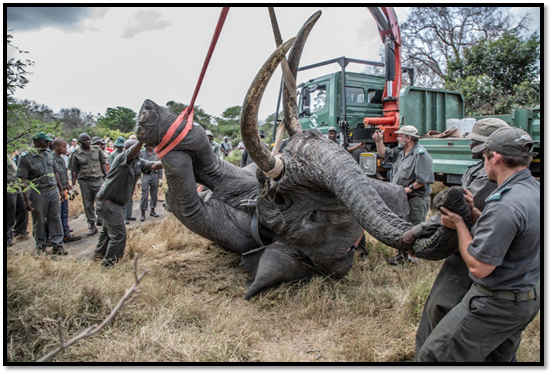
Courtesy of the Sunday Times: Project Rewild Zambesi underway
Tinashe Farawo, Zimparks spokesman was quoted as saying: “We issued the permits after doing thorough assessments and research. Our ecologist and zoologists as well as others from South Africa assisted us in carrying out assessments on security, availability of water and food before a decision was made to translocate the animals” and added that this wildlife transfer operation was the second-largest in Zimbabwe since Operation Noah in 1958 – 1964 when Kariba Dam was being constructed.[ii]
The relocation project termed ‘Project Rewild Zambesi’ has begun
In a September article Farai Mutsaka wrote that a helicopter had been herding thousands of impala into an enclosure and a crane had been lifting sedated elephants upside down into trailers. Other wildlife was being driven into steel cages by Savé Valley Conservancy and Zimparks game rangers to be loaded onto trucks and from their former conservancy driven approximately 700 km (435 miles) to the three conservancies in the north — Sapi, Matusadona and Chizarira.[iii]
Climate change has been a big driver of wildlife relocation
The effects of climate change on wildlife are being felt across Africa especially in East and Central Africa. Across Africa, national parks are finding that their populations of elephants, buffaloes, lions and antelope are being increasingly threatened by below-average rainfall causing drought as well as human interventions including new infrastructure projects and deforestation.
Tinashe Farawo said: “We are doing this to relieve pressure. For years we have fought poaching and just as we are winning that war, climate change has emerged as the biggest threat to our wildlife. Many of our parks are becoming overpopulated and there is little water or food. The animals end up destroying their own habitat, they become a danger unto themselves and they encroach neighbouring human settlements for food resulting in incessant conflict.”
Prolonged drought seriously threatens the elephant, rhino, giraffe and antelope populations as it reduces the amount of food available. In the past one option used in Zimbabwe in the 1980’s was to cull elephant numbers, but conservation groups protest that such killings are cruel.
Climate change clearly is not isolated to Zimbabwe and the project will also aim to rebuild the numbers of wildlife in the Zambesi River Valley that have been decimated by years of unchecked poaching because the resources of Zimparks were stretched too thinly.
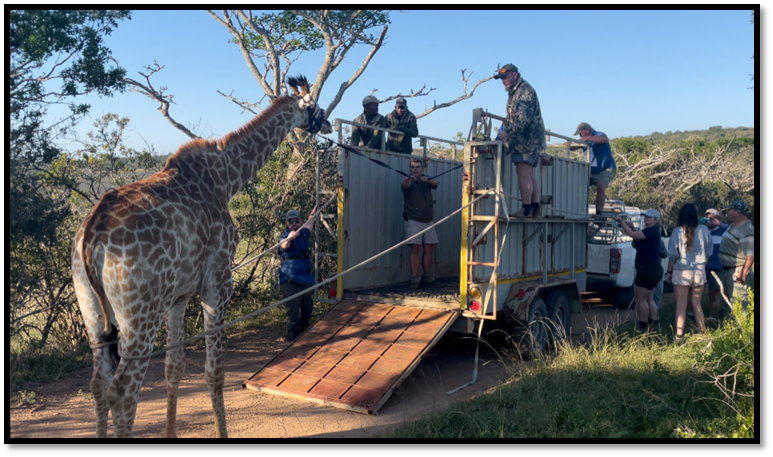
Courtesy of globalvetexperience: Giraffe capture for relocation
Conservation Groups and NGO’s are in Zimbabwe to assist Zimparks
One of the leading conservation groups involved is the Great Plains Foundation, a non-profit organization that works: “to conserve and expand natural habitats in Africa through innovative conservation initiatives.”
This very welcome trend is for Zimparks to work in collaboration with organisations such as Great Plains Foundation who in turn consult with local experts including the Zambesi Valley Conservation Network and the Zambesi Society (Zamsoc) the University of Washington-Seattle’s Centre for Environmental Forensic Science and Oxford University’s Department of Zoology.
Sapi Reserve will be the new home for the translocated animals
Sapi Reserve is a privately-run 280,000-acre concession east of Mana Pools National Park, the UNESCO World Heritage Site known for its spectacular location on the Zambezi River. Dereck Joubert, Great Plains Foundation’s chief executive officer, wrote that Sapi Reserve: “is the perfect solution for many reasons. This reserve forms the middle-Zambezi biosphere, totalling 1.6 million acres. From the 1950s until we took it over in 2017, decades of hunting had decimated wildlife populations in Sapi Reserve. We are rewilding and restoring the wild back to what it once was.”
This model of collaboration and forming partnerships between an over-stretched Zimparks and conservation organisations has been successively repeated at Matusadona National Park on the lakeshore of Lake Kariba with African Parks.
The efforts and logistics behind this relocation are awe-inspiring
Dereck Joubert of the Great Plains Foundation which is running the project in collaboration with its local partners said “Savé Valley Conservancy urgently needed to reduce its wildlife population to allow the remainder a better chance of survival.[iv] We had the perfect habitat available at the Sapi Reserve — an empty former hunting concession on the Zambezi — and we had the experts on hand to plan and execute such a complex operation.”
With Zimbabwe’s summer rain’s approaching from November the relocation plan needed to be implemented fast and was drawn up in three months. Much credit for this must go to Zimparks for doing the mandatory assessments and research and getting the go-ahead for the permits.
Sven Bourquin, a conservation ecologist, who leads the wildlife monitoring efforts of the Great Plains Foundation and Rhinos without Borders said much effort went into cutting routes for the wildlife game-catching teams and they hired earth-moving equipment to reinforce and grade the route within the Savé Valley Conservancy and inspected the highways to the Sapi Reserve to ensure they could support 32-ton trucks.
“Working with animals like elephants is an incredibly costly and dangerous process. We need to pay for helicopters, marksmen, veterinary care and supervision on the road. The money has drained away like water from a leaky bucket.”
Dereck Joubert said that the relocation project will cost $5.5 million with the first $2.75 million coming from Great Plains Foundation itself and he hopes the balance will come from a series of crowdfunding campaigns.
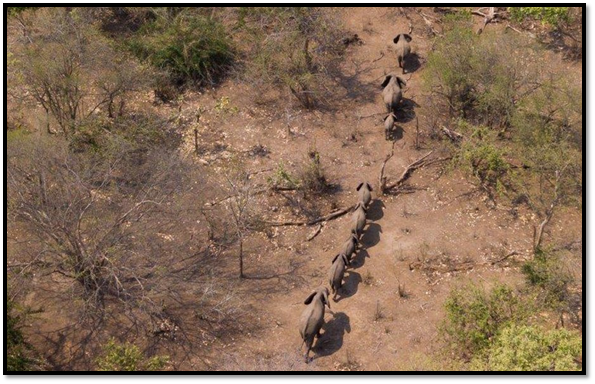
Courtesy of Associated Press: Elephants being herded by helicopter to an enclosure
Ethical and humane considerations guide Savé Valley Conservancy and Great Plains Foundation
Joubert said: “that in all cases, entire herds, clans, prides and packs will be taken. Helicopters herd elephants towards muster points where they are darted, tagged, hoisted onto trucks with industrial cranes and driven to the road head.
When, on one occasion, a single elephant evaded the sharpshooter, the rest of the herd, darted and unconscious, was revived and released. Elephants are socially complex animals and they mourn missing relatives, so the rule is that we either take the entire family to Sapi, or we take none of them, and that goes for all species.”
Progress is continuing quickly
So far 101 elephants have been relocated and the helicopters are scouring the bush for family groups before the summer rainfall arrives — when it becomes too hot and wet to transport wildlife — other capture teams are deploying traps to catch other species.
Rob Reese, the lead vet said: “A boma [stockade] is set up in advance, comprising a funnel of screens through which animals can be herded directly into the transport vehicle. It seems straightforward, but all species have their own unique problems, be it size, family make-up, ability to transport in a single compartment or interaction between members of a group. All can affect the ease or difficulty of a capture operation.”
Josh Mostert of African Wildlife Management & Conservation said: “Impala can be very difficult to herd with a helicopter. The animals are jumpy and easily spooked, putting pilots in danger. Sables are easier to catch but can injure each other when leaving the truck. Elephants need a huge amount of equipment, and their delivery is fraught with challenges; and buffalo are very dangerous and destructive. Giraffes, too, are potentially lethal. When you wake them, they jump up immediately, leaving us little time to get out of the way.”
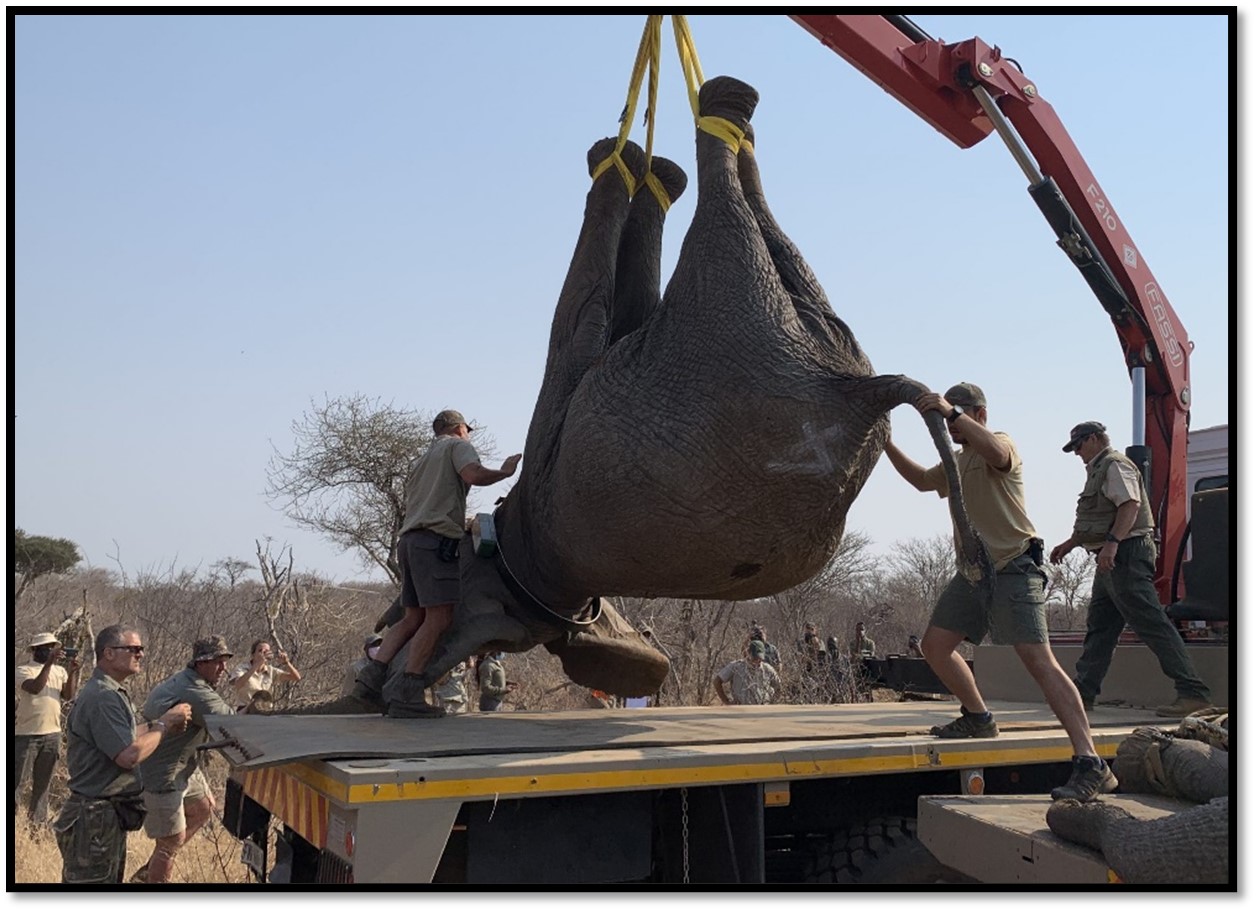
Courtesy of Independent Online (IOL) Darted elephant being loaded for relocation
Events are not always straightforward
The animals health is checked before each convoy departs and the monitoring by vets continues throughout the journey.
Jacqueline La Grange on the vet team said: “Anything and everything can go wrong. After one capture, we had a truckload of zebras separated into family groups in three compartments. The driver wedged the truck under a low branch and in attempting to get free he dislodged a bees’ nest that dropped into the vehicle. In the ensuing chaos the compartment doors were broken down and the herds got mixed up. That’s a hard situation to anticipate.”
Sven Bourquin, told the Sunday Times that moving each elephant by truck costs $10,000 and they were (naturally!) nervous passengers. Matriarchs are tranquillised for the 20-hour journey, but other family members are fully conscious. He added: “The drivers must not stop in public places, they can’t use their horns, need to be gentle on the brakes and avoid potholes. We had to fit screens in the trucks when we realised the elephants were becoming distressed by the headlights of passing cars at night. We move in groups of between eight and ten per truck, and if a young bull gets frisky in the wagon we have to tranquillise him.”
Arrival at their destination at Sapi Reserve
The logistics experts say that the last leg of the journey to Sapi Reserve is the most hazardous. From Makuti, the A1 highway makes a steep and twisting descent down the escarpment to the Zambesi valley floor. Sven Bourquin says: “God forbid that a truck turns over here, but it could happen.” This author has seen numerous fatal lorry accidents at this part – it does happen.
On arrival at the Sapi Reserve, the lorries pull into another boma. Tracking devices are fitted to some animals, antidotes are administered to the tranquillised animals, the ramps are lowered and the animals are left to exit the vehicles in their own time. The boma offers food, water and the opportunity for the wildlife to become accustomed to their surroundings, a rich environment of riverine forest and water meadows is very different from the scorched former cattle country of the Savé Valley.
When the animals are relaxed, a section of fence is removed and they are free to explore the 2,500 square miles of their new home. So far, 101 elephants and 184 impala have been moved to the reserve without a single fatality. Dereck Joubert said: “The game capture manuals consider a mortality rate of up to 5 per cent to be acceptable, but for us, even a single death is unacceptable.”
Sven Bourquin said: “To achieve a zero-casualty translocation, it’s never good enough to have experts on the job. You need people with an emotional investment in the project, even to the point that they will put themselves at risk to ensure the welfare of the animals. We need compassion out here as much as we need professionalism.”
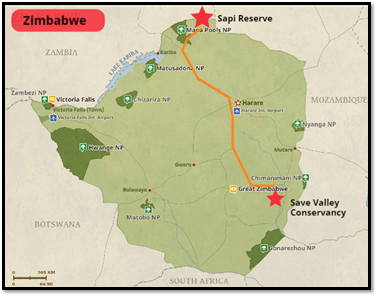
Graphic showing the route from Save Valley Conservancy to Sapi Reserve
Are large-scale translocations like this one inevitable in the future?
Dereck Joubert told the Sunday Times he thought of Project Rewild Zambezi as a small-scale pilot for the large-scale translocations of wildlife that he believes are inevitable in the future. He quoted Conservation International who believe seven of the ten countries most vulnerable to climate change are in Africa as drought and soil erosion have degraded 65 per cent of the continent’s grassland, threatening the livelihoods of 100 million herders and farmers. In addition funding deficiencies and political expediency put many of Africa’s 7,800 protected areas at risk of human incursion, forcing out wildlife and wiping out natural habitats.
He said: “What’s happening now is an emergency intervention, because if we don’t move these animals they will die. Within years, though, such relocations will become routine and we’ll be moving tens of thousands of animals around the continent to maintain the biodiversity upon which ecosystems depend, so we’re developing an open source methodology that anyone can copy. We make no profit from this, but we don’t mind if others do, if it’s for the benefit of wildlife and environment.”
References
Journal of African Elephants (https://www.africanelephantjournal.com)
Notes
[i] Jerry Omondi, CGTN. 26 July 2022. Zimbabwe begins relocation of over 2,600 wild animals as drought worsens
[ii] Operation Noah led by Rupert Fothergill successfully moved more than 5,000 animals from islands in the soon to be flooded Lake Kariba region that were to be flooded to the lakeshore between 1958 and 1964.
[iii] Farai Mutsaka, Associated Press. 2 Sept 2022. Zimbabwe moves 2,500 wild animals due to climate change. https://www.washingtonpost.com/world/zimbabwe-moves-2500-wild-animals-due-to-climate-change/2022/09/01/ee0e7dd2-29cc-11ed-a90a-fce4015dfc8f_story.html
[iv] Chris Haslam. Sep 26, 2022. The Sunday Times. Zimbabwe: Cranes, helicopters and easy on the brakes: saving 400 elephants from drought. https://www.thetimes.co.uk/article/cranes-helicopters-and-easy-on-the-brakes-saving-400-elephants-from-drought-zb5scs0wd
